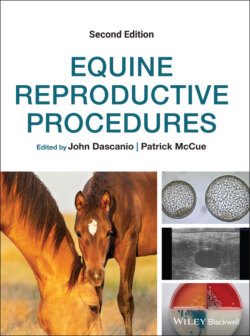Читать книгу Equine Reproductive Procedures - Группа авторов - Страница 42
Technique
ОглавлениеRemove feces from the rectum.
Place a tail wrap and tie the tail out of the way (see Chapter 4).
Clean and dry the perineum of the mare (see Chapter 3).
Place a sterile sleeve on the arm.
Place the guarded culture device into the palm of the hand.
Place sterile lubricant on the knuckles and down the length of the sleeve being careful not to get lubricant onto the palm. If the culture device becomes inundated with lubricant, it may be more difficult to obtain a diagnostic sample.
Rub lubricant from the knuckles onto the vulva, straighten the fingers and insert through the vulva, staying dorsal so as to not rub across the clitoris.
Using a slight rotating motion, pass the hand into the vagina so that the mid‐forearm is to about the level of the vulva. This should enable palpation of the external cervical os.
Gently insert the index finger into the external cervical os. Sometimes the os may be off‐center, located slightly downward, or to the left or right of center.
Pass the index finger through the cervix to the last knuckle (metacarpo‐phalangeal joint). Usually one can tell when the tip of the finger exits the internal cervical os and enters the uterine body lumen.
Insert the uterine swab/brush instrument along the inserted index finger through the cervix and into the uterine lumen. Sometimes, if the cervical canal is under the influence of progesterone and is toned, the index finger may need to be removed prior to passing the culture device. Typically, the instrument would be pointed in a slightly downward direction when being passed through the cervix due to the dependent nature of the suspended uterus within the abdomen.
The inner swab/brush is then advanced forward through the cap/guard.
Allow the swab/brush to be in contact with the endometrium and uterine secretions for 10–15 seconds and then reverse the procedure to remove the device.
Gentle rotation of the swab/brush may be indicated to pick up cells, but care should be taken to limit “heavy‐handed” movements of the uterine culture swab as this may predispose to breaking of the end of the swab or may be associated with mild hemorrhage and contamination of the swab with blood.
Once the culture instrument has been withdrawn from the external cervical os, a cupped hand should be placed over the device to limit vaginal cellular contamination to the swab/brush.
If a single swab was used, the swab should be gently rolled over a sterile microscope slide (and can then still be used for uterine culture). If a sterile slide is not available, then a second swab may be used to obtain a uterine culture.
If a single brush is used, a swab of the brush may be made for culture and then the brush rolled gently over a microscope slide. If the material discharged is thick, a second slide is placed over the first and gently pulled apart to create a smear.
It is also common practice to collect two samples from a mare; first a swab for microbial culture and then a brush sample for endometrial cytology.
Two slides are prepared from every sample in the event that one is broken prior to evaluation or if more than one stain is to be used.
Microscope slides should be air‐dried and may be fixed to preserve cellular architecture. The slides may then be stained with a modified Wright’s stain such as Diff‐Quik®.
Additional stains that may be considered are a Gram stain or a fungus‐specific stain such as Grocott methenamine silver (GMS) stain.
